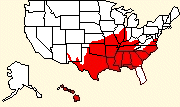|
Red-eared Slider
|
- Order: Testudines (turtles)
- Suborder: Cryptodira (all turtles besides
side-necked turtles)
- Family: Emydidae (semiaquatic turtles)
- Subfamily: Deirochelyinae (sliders and map
turtles)
- Genus: Trachemys (sliders)
|
| Also known as: Redear,
Red-eared Turtle, Red-eared Pond Slider |
Scientific Name: Trachemys scripta
elegans (Wied, 1838) |
| Habitat: Ponds, lakes,
and other slow-moving bodies of water. |
Trachys="rough," emys="turtle,"
scripta="marked," elegans="elegant"
|
| Length: Shell to almost 12
inches for females. Males are usually much smaller. |
Previous Scientific
Names: Pseudemys scripta elegans, Chrysemys scripta
elegans |
| Food: Young are
omnivorous; adults typically eat mostly plant material. |
 |
|
Sliders are abundant in the lakes of Little Rock
AFB. Although they are numerous, they are skittish and it's
hard to approach close enough for a good photograph. The
first picture is of a large adult in the backwaters of the smaller
of the two main lakes. The second picture is of a male (the
smaller turtle) courting a female by stroking her face with his
long front claws. |
 |
|
The read "ears" are a popular feature;
millions of these turtles have been sold as pets (though in the US
it's now illegal to sell turtles under 4 inches in length except
for educational purposes). Young turtles are typically the
most colorful. Older specimens tend to fade with age, and
some old males become nearly black. Additionally, the older
turtles often develop algae on their carapaces which obscures any
residual markings.
|
 |
| The final two pictures are of a
young turtle I caught on hook and line on 30 September 2004.
I don't even think the turtle was hooked, but it stubbornly
wouldn't let go of my bait until I had pulled it ashore. |
 |
| Sliders are probably the most
abundant turtle in the United States. They originated in the
southeast, but have been introduced nationwide and also to
Europe. The map shown here is a little more of a historical
range (besides Hawai'i, of course). I've seen them in
Washington State as well (obviously introduced). |
 |
|
See also the sliders in Texas. |
|